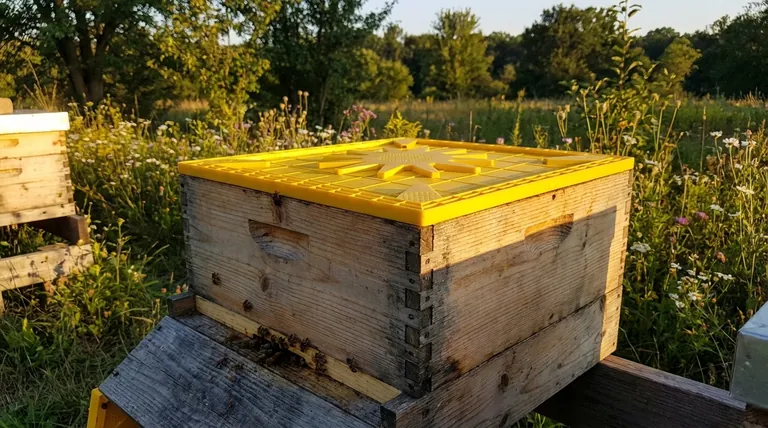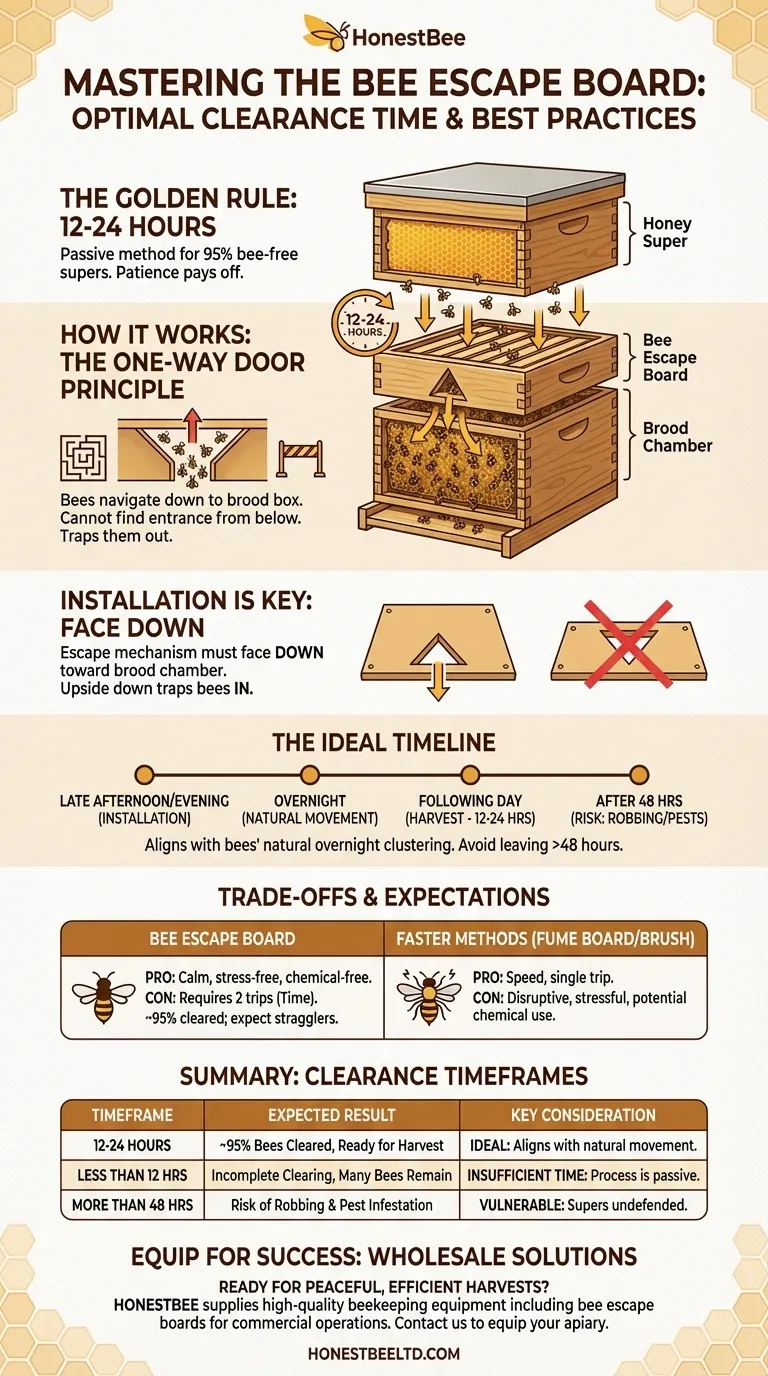To clear your honey supers effectively, a bee escape board should be left on the hive for approximately 12 to 24 hours. This passive method allows bees to move down into the brood chamber on their own, resulting in a nearly bee-free super ready for harvest with minimal disturbance to the colony.
The bee escape board is a tool for patience, not speed. Its purpose is to create a gentle, one-way exit from the honey supers, leveraging the bees' natural movement. Success hinges on giving them sufficient time, typically overnight, to vacate the supers calmly.

How a Bee Escape Board Works
A bee escape is a simple but ingenious device. It functions as a one-way door, allowing bees to leave an area but preventing their return.
The Principle of One-Way Travel
The board contains one or more small passages, often shaped like a triangle or maze. Bees can easily navigate their way down and out of these passages to rejoin the main cluster in the brood box below.
However, when they try to return to the honey super, they cannot find the tiny entrance to the passage from underneath, effectively trapping them out of the super.
Proper Installation is Crucial
For the board to work, it must be installed correctly. Place the bee escape board directly underneath the honey supers you intend to harvest and above the lower hive bodies (brood boxes).
The side with the escape mechanism (e.g., the triangle opening) must face down, toward the brood chamber. If installed upside down, you will trap bees in the super instead of clearing them out.
The Ideal Timeframe
While some bees will exit within a few hours, the process is most effective when left for 12 to 24 hours. This allows the entire population within the supers, including foragers returning from the field, ample time to move down.
Placing the board in the late afternoon or evening and returning the following day is a reliable strategy that aligns with the bees' natural tendency to cluster together overnight.
Understanding the Trade-offs and Pitfalls
While highly effective, the bee escape board is not a perfect or instantaneous solution. Understanding its limitations is key to a successful harvest.
It Requires a Second Trip
The primary trade-off is time. Unlike using a fume board or bee brush, which clears bees immediately, the escape board requires you to visit the apiary on two separate days: one to install the board and another to remove the cleared supers.
Don't Leave It On Too Long
Leaving the board on for more than 48 hours is not recommended. If a nectar flow stops, bees from other hives may discover the undefended honey, leading to robbing.
Furthermore, pests like wax moths or small hive beetles could take advantage of a super with no bees to defend it. The 24-hour window is the sweet spot for effectiveness and safety.
Managing Expectations: The Remaining 5%
A bee escape board will clear approximately 95% of the bees. It is perfectly normal to find a few dozen stragglers remaining in the super.
These remaining bees are usually calm and can be gently brushed off the frames with a bee brush as you transfer them into a sealed container for transport.
Check for Blockages or a Trapped Queen
Rarely, the escape exit can be blocked by a drone (which is larger than a worker bee) or by propolis. More critically, if a queen is accidentally in the honey super when the board is placed, she will be trapped. Always ensure your queen is in the brood chamber before installing the board.
Making the Right Choice for Your Harvest
Using a bee escape board is a decision based on your goals for the harvest process.
- If your primary focus is a calm, stress-free harvest: The bee escape board is the best tool, as it avoids the use of chemicals and the agitation caused by brushing or blowing.
- If your primary focus is speed and a single-trip harvest: Consider other methods like a fume board or a bee blower, but be aware they are more disruptive and stressful for the colony.
- If you are a new beekeeper: The bee escape board is highly recommended for its simplicity, gentle impact, and reliability.
By giving the bees a full day's cycle to vacate, you ensure a peaceful harvest for both you and your colony.
Summary Table:
| Timeframe | Expected Result | Key Consideration |
|---|---|---|
| 12-24 hours | ~95% of bees cleared; super ready for harvest. | Ideal duration; aligns with bees' natural overnight movement. |
| Less than 12 hours | Incomplete clearing; many bees may remain. | Process is passive and requires sufficient time. |
| More than 48 hours | Risk of robbing from other hives or pest infestation. | Supers are left undefended for too long. |
Ready for a peaceful, efficient honey harvest? The right equipment makes all the difference. HONESTBEE supplies commercial apiaries and beekeeping equipment distributors with high-quality, reliable beekeeping supplies, including bee escape boards, through our wholesale-focused operations. Let us help you equip your operation for success. Contact our team today to discuss your needs and place your order!
Visual Guide

Related Products
- HONESTBEE Multi Exit Plastic Bee Escape Board for Efficient Honey Harvesting
- High-Efficiency Diamond Maze Bee Escape for Clearing Supers
- Circular Labyrinth Bee Escape for Efficient Hive Management
- Durable 16 Way Circular Bee Escape for Efficient Honey Harvesting
- Professional Durable Two-Piece Plastic Bee Escape
People Also Ask
- What is an escape board used for? A Gentle, Chemical-Free Honey Harvest
- How should bee escape boards be used for optimal results? A Guide to a Calm, Efficient Honey Harvest
- What is the result of using a bee escape board for 24 hours? Achieve a Near Bee-Free Honey Super
- What is the method of separating bees from honey supers using the Bee Escape Board? A Gentle, Low-Stress Harvesting Guide
- Where should the Bee Escape board be placed? For a Calm, Bee-Free Honey Harvest



















